What is Hypertension?
Hypertension is a dangerous condition because there are few recognizable symptoms. Sometimes when blood pressure is very high, some people experience headaches and dizziness, but oftentimes there is no indication at all. Therefore, diagnosis requires that blood pressure be taken regularly, preferably not only in the doctor’s office. Many pharmacies have a free blood pressure cuff to measure this important indicator of circulatory health. Another way of describing “blood pressure” is the force required to pump the blood through the body.
Systolic and Diastolic Blood Pressure Measurements
There are two blood pressure measurements, systolic – when the heart muscle is contracting, and diastolic – when the heart is relaxing between beats. Ideally, blood pressure should be no higher than 120 over 80. As we age, the arteries stiffen, and blood pressure rises, so that the heart must work harder to pump the blood. Many people require multiple medications to control blood pressure.
Salt and Hypertension
As with many cardiovascular conditions, diet plays an enormous role. Too much salt or sodium in the diet can lead to hypertension or high blood pressure. Exercise can help the arteries relax. It is always preferable to prevent hypertension or reduce it by lifestyle changes, rather than to take a greater number and higher doses of medications, many of which have unpleasant side effects.
Small steps help. For example, if we eat breads several times day, that can add up to a lot of sodium. Check labels to find lower-sodium varieties and try to scale down or find a subsitute fruit or uncooked vegetable instead. One 2 oz serving or 6 thin slices of cold cuts and cured meats can contain as much as half of your daily recommended dietary sodium. Again, find lower sodium alternatives or look for healthier substitutes. If you are trying to control your cholesterol, avoid this type of cold cut completely.
Risks of Chronic Hypertension?
Chronic and uncontrolled hypertension can lead to stroke, heart attack, heart failure, aneurysms, kidney failure, peripheral disease, and weakening of the entire system.
